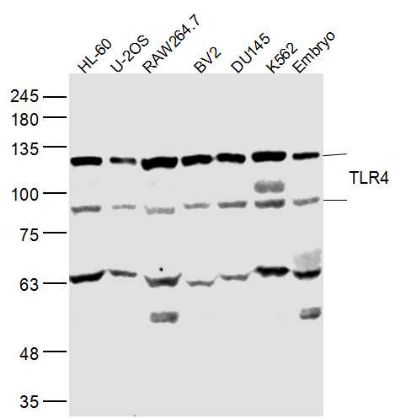上海细胞库
人源细胞系| 稳转细胞系| 基因敲除株| 基因点突变细胞株| 基因过表达细胞株| 重组细胞系| 猪的细胞系| 马细胞系| 兔的细胞系| 犬的细胞系| 山羊的细胞系| 鱼的细胞系| 猴的细胞系| 仓鼠的细胞系| 狗的细胞系| 牛的细胞| 大鼠细胞系| 小鼠细胞系| 其他细胞系|

| 规格 | 价格 | 库存 |
|---|---|---|
| 50ul | ¥ 980 | 200 |
| 100ul | ¥ 2480 | 200 |
| 中文名称 | Toll样受体4抗体 |
| 别 名 | TLR4; TLR-4; TLR 4; ARMD10; CD 284; CD284; CD284 antigen; Homolog of Drosophila toll; hTol; Toll (Drosophila) homolog; TOLL; Toll Endotoxin Hyporesponsiveness; Toll like receptor 4; Toll like receptor 4 precursor; TLR4_HUMAN. |
| 抗体来源 | Rabbit |
| 克隆类型 | Polyclonal |
| 交叉反应 | Human, Mouse, Rat, Cow, (predicted: Pig, Horse, Rabbit, Sheep, ) |
| 产品应用 | WB=1:1000-2000 ELISA=1:1000-5000 IHC-P=1:500-1000 IHC-F=1:500-1000 ICC=1:100-500 IF=1:200-1000 (石蜡切片需做抗原修复) not yet tested in other applications. optimal dilutions/concentrations should be determined by the end user. |
| 分 子 量 | 90kDa |
| 细胞定位 | 细胞膜 |
| 性 状 | Liquid |
| 浓 度 | 1mg/ml |
| 免 疫 原 | KLH conjugated synthetic peptide derived from human TLR4:701-800/839 |
| 亚 型 | IgG |
| 纯化方法 | affinity purified by Protein A |
| 储 存 液 | 0.01M TBS(pH7.4) with 1% BSA, 0.03% Proclin300 and 50% Glycerol. |
| 保存条件 | Shipped at 4℃. Store at -20 °C for one year. Avoid repeated freeze/thaw cycles. |
| PubMed | PubMed |
| 产品介绍 | The Toll-like receptor 4 by activating natural immunity, specific immune response involved in the start-up, Toll-like receptor 4 as an important signal transduction transmembrane receptor involved in the toxin-induced inflammation in the pathological process, its mechanisms of control On a growing concern. all regions were either double-stranded or sequenced with an alternatechemistry or covered by high quality data(i.e., phred quality >=30); an attempt was made to resolve all sequencing problems, such as compressions and repeats; all regions were covered by at least one subclone; and the assembly was confirmed by restriction digest, except on the rare occasion of the clone being a YAC. The following abbreviations are used to associate primary accession numbers given in the feature table with their source databases: Em:, EMBL; Sw:, SWISSPROT; Tr:, TREMBL; Wp:, WORMPEP; Information on the WORMPEP database can be found at. TLR-4 plays an important role in microvascular leakage and leukocyte adhesion under the inflammatory condition associated with nonseptic thermal injury. Function: Cooperates with LY96 and CD14 to mediate the innate immune response to bacterial lipopolysaccharide (LPS). Acts via MYD88, TIRAP and TRAF6, leading to NF-kappa-B activation, cytokine secretion and the inflammatory response. Also involved in LPS-independent inflammatory responses triggered by Ni(2+). These responses require non-conserved histidines and are, therefore, species-specific. Subcellular Location: Membrane; Single-pass type I membrane protein. Tissue Specificity: Highly expressed in placenta, spleen and peripheral blood leukocytes. Detected in monocytes, macrophages, dendritic cells and several types of T-cells. Post-translational modifications: N-glycosylated. Glycosylation of Asn-526 and Asn-575 seems to be necessary for the expression of TLR4 on the cell surface and the LPS-response. Likewise, mutants lacking two or more of the other N-glycosylation sites were deficient in interaction with LPS. DISEASE: Genetic variation in TLR4 is associated with age-related macular degeneration type 10 (ARMD10) [MIM:611488]. ARMD is a multifactorial eye disease and the most common cause of irreversible vision loss in the developed world. In most patients, the disease is manifest as ophthalmoscopically visible yellowish accumulations of protein and lipid that lie beneath the retinal pigment epithelium and within an elastin-containing structure known as Bruch membrane. Similarity: Belongs to the Toll-like receptor family. Contains 18 LRR (leucine-rich) repeats. Contains 1 LRRCT domain. Contains 1 TIR domain SWISS: O00206 Gene ID: 7099 Database links: Entrez Gene: 7099 Human Entrez Gene: 21898 Mouse Entrez Gene: 29260 Rat SwissProt: O00206 Human SwissProt: Q9QUK6 Mouse SwissProt: Q9QX05 Rat Unigene: 174312 Human Unigene: 38049 Mouse Important Note: This product as supplied is intended for research use only, not for use in human, therapeutic or diagnostic applications. |
| 产品图片 |  Sample: Sample:HL60 (Human) Lysate at 30 ug Primary: Anti- TLR4 (bs-20594R) at 1/300 dilution Secondary: IRDye800CW Goat Anti-Rabbit IgG at 1/20000 dilution Predicted band size: 90 kD Observed band size: 90 kD  Sample: Sample:K562(Human) Cell Lysate at 40 ug HL-60(Human) Cell Lysate at 40 ug RAW264.7(Mouse) Cell Lysate at 40 ug Primary:Anti-TLR4 (bs-20594R) at 1/2000 dilution  Sample: Sample:HL-60(Human) Cell Lysate at 40 ug U-2OS(Human) Cell Lysate at 40 ug RAW264.7(Mouse) Cell Lysate at 40 ug BV2(Mouse) Cell Lysate at 40 ug DU145(Human) Cell Lysate at 40 ug K562(Human) Cell Lysate at 40 ug Embryo (Mouse) Lysate at 40 ug Primary: Anti-TLR4 (bs-20594R) at 1/300 dilution  Sample: Sample:Lane 1: Jurkat (Human) Cell Lysate at 30 ug Lane 2: HUVEC (Human) Cell Lysate at 30 ug Lane 3: U-2OS (Human) Cell Lysate at 30 ug Lane 4: Lymph node (Mouse) Lysate at 40 ug Lane 5: Raw264.7 (Mouse) Cell Lysate at 30 ug Primary: Anti-TLR4 (bs-20594R) at 1/1000 dilution Secondary: IRDye800CW Goat Anti-Rabbit IgG at 1/20000 dilution Predicted band size: 100-135 kD Observed band size: 120 kD  This image was generously provided by Juanli Fu, at Southwest University in Chong Qing, China. 4% Paraformaldehyde fixed PC12 cells stained with Rabbit Anti- TLR4 Polyclonal Antibody (bs-20594R) at 1:300 for 3 hours at 4°C, followed by Alexa Fluor 488-conjugated secondary antibody for an additional hour. This image was generously provided by Juanli Fu, at Southwest University in Chong Qing, China. 4% Paraformaldehyde fixed PC12 cells stained with Rabbit Anti- TLR4 Polyclonal Antibody (bs-20594R) at 1:300 for 3 hours at 4°C, followed by Alexa Fluor 488-conjugated secondary antibody for an additional hour. |